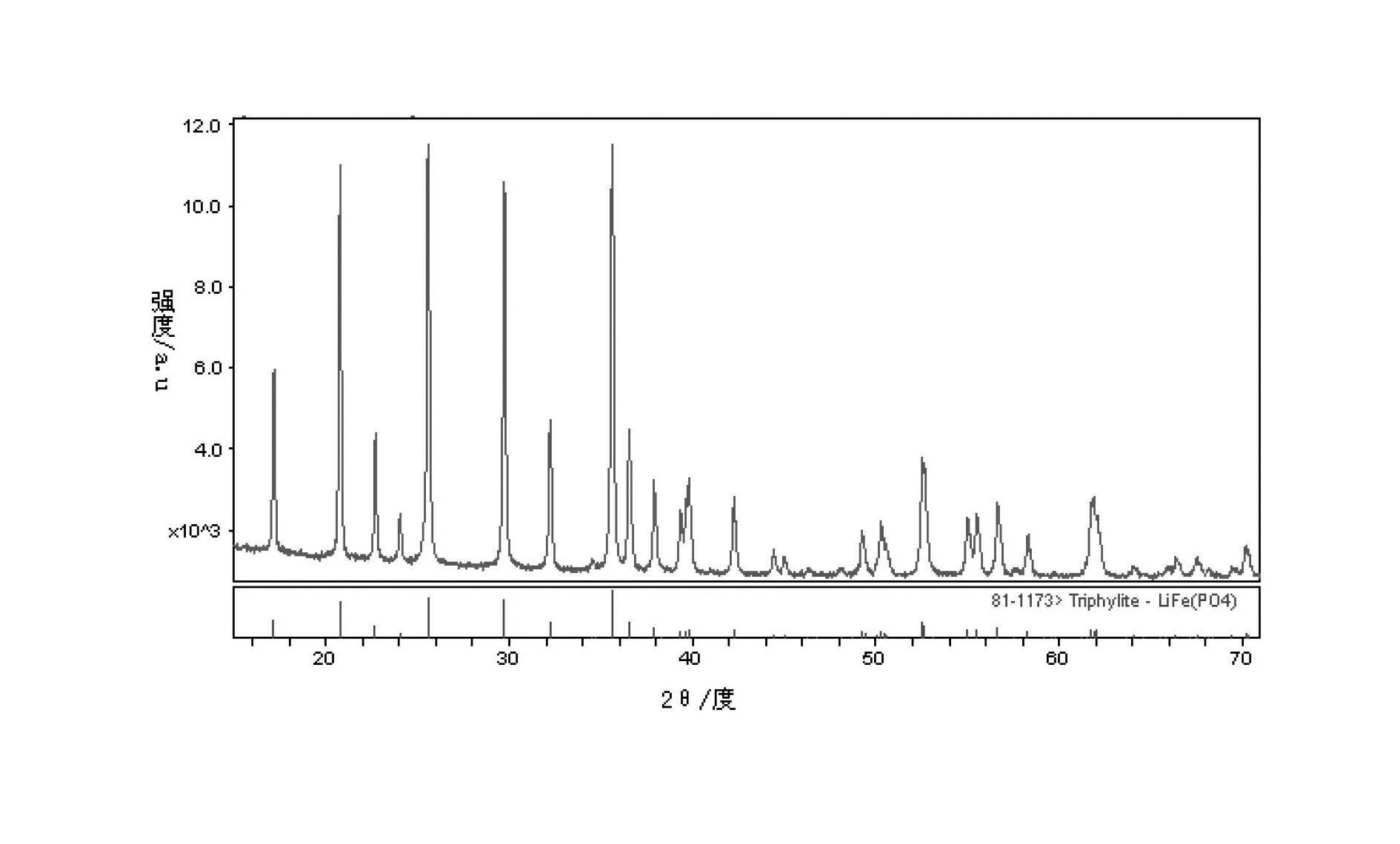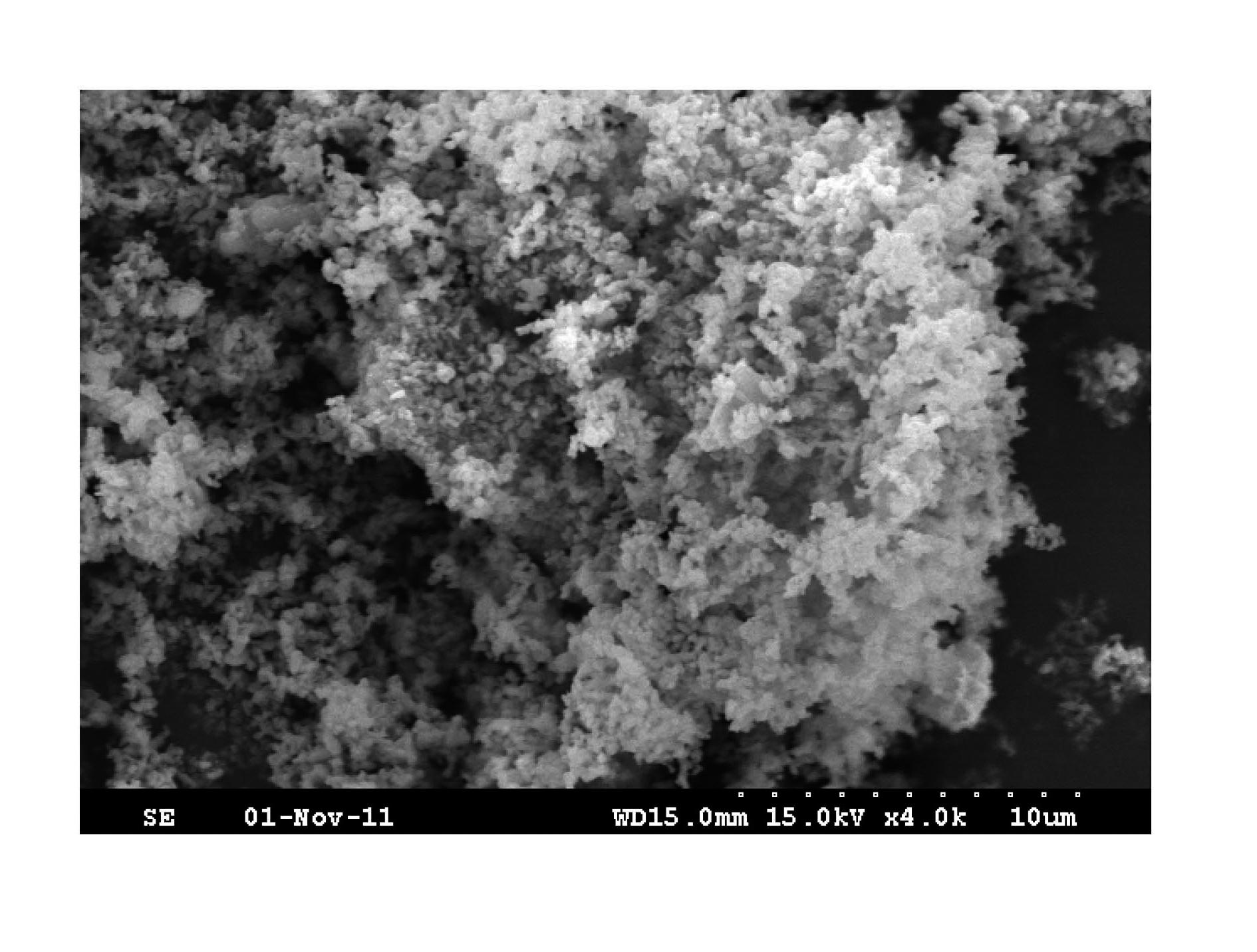Preparation method for low-temperature nanometer lithium iron phosphate cathode material
A technology of lithium iron phosphate and cathode material, applied in battery electrodes, electrical components, circuits, etc., can solve problems such as poor low temperature performance
- Summary
- Abstract
- Description
- Claims
- Application Information
AI Technical Summary
Problems solved by technology
Method used
Image
Examples
Embodiment 1
[0019] 2.55molLi 2 CO 3 , 2.5molFe 2 o 3 , 5.0mol NH 4 h 2 PO 4 Add to the mixing tank, add 2L deionized water, add 0.01molMnO while stirring 2 , 0.01molTiO 2 and 30g of glucose, stirred evenly, transferred to a ball mill, and performed a high-energy ball mill for 2 to 3 hours, and the D50 of the obtained slurry must be less than 0.1 μm. Then carry out spray drying to form powder, and sieve. put the powder in N 2 In the atmosphere, it was sintered in a rotary furnace at 350° C. for 5 hours. Cool, sieve, transfer to a ball mill jar, add 150g chitosan and 900ml deionized water, stir evenly, transfer to a ball mill, perform a second high-energy ball mill until the D50 of the slurry is less than 0.1 μm, and spray dry to form a spherical shape Powder, sieved. After the powder is subjected to airflow pulverization, it is added to the rotary kiln, and the N 2 Sinter at 650°C for 8 hours in the atmosphere, then heat up to 800°C for 20 hours, cool, sieve and obtain the prod...
Embodiment 2
[0022] 2.55molLi 2 CO 3 , 5.0molFePO 4 Add to the mixing tank, add 2L deionized water, add 0.01molMnO while stirring 2 , 0.01molTiO 2 , 0.02mol MgO and 30g glucose, stirred evenly, transferred to a ball mill, and performed a high-energy ball mill for 2 to 3 hours, and the D50 of the obtained slurry must be less than 0.1 μm. Then carry out spray drying to form powder, and sieve. put the powder in N 2 In the atmosphere, it was sintered in a rotary furnace at 350° C. for 5 hours. Cool, sieve, transfer to a ball mill jar, add 150g chitosan and 900ml deionized water, stir evenly, transfer to a ball mill, perform a second high-energy ball mill until the D50 of the slurry is less than 0.1 μm, and spray dry to form a spherical shape Powder, sieved. After the powder is subjected to airflow pulverization, it is added to the rotary kiln, and the N 2 Sinter at 650°C for 8 hours in the atmosphere, then heat up to 800°C for 20 hours, cool, sieve and obtain the product.
[0023] The...
Embodiment 3
[0025] 2.55molLi 2 CO 3 , 2.5molFe 2 o 3 , 5.0mol NH 4 h 2 PO 4 Add to the mixing tank, add 2L deionized water, add 0.01molMnO while stirring 2 , 0.01molTiO 2 and 30g of sucrose, stirred evenly, transferred to a ball mill, and carried out a high-energy ball mill for 2 to 3 hours, and the D50 of the obtained slurry must be less than 0.1 μm. Then carry out spray drying to form powder, and sieve. put the powder in N 2 In the atmosphere, it was sintered in a rotary furnace at 350° C. for 5 hours. Cool, sieve, transfer to a ball mill tank, add 180g of modified starch and 900ml of deionized water, stir evenly, transfer to a ball mill, perform a second high-energy ball mill until the D50 of the slurry is less than 0.1 μm, and spray dry to form a spherical shape Powder, sieved. After the powder is subjected to airflow pulverization, it is added to the rotary kiln, and the N 2 Sinter at 650°C for 8 hours in the atmosphere, then heat up to 800°C for 20 hours, cool, sieve and...
PUM
| Property | Measurement | Unit |
|---|---|---|
| Grain size | aaaaa | aaaaa |
| Size | aaaaa | aaaaa |
| Size | aaaaa | aaaaa |
Abstract
Description
Claims
Application Information
 Login to View More
Login to View More - R&D
- Intellectual Property
- Life Sciences
- Materials
- Tech Scout
- Unparalleled Data Quality
- Higher Quality Content
- 60% Fewer Hallucinations
Browse by: Latest US Patents, China's latest patents, Technical Efficacy Thesaurus, Application Domain, Technology Topic, Popular Technical Reports.
© 2025 PatSnap. All rights reserved.Legal|Privacy policy|Modern Slavery Act Transparency Statement|Sitemap|About US| Contact US: help@patsnap.com



